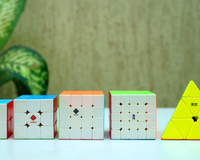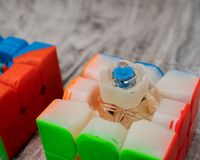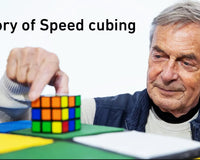Introduction
The 4x4 Yau method is arguably the fastest and most efficient method to solve a 4x4. The Yau method was proposed in 2009 by Robert Yau, and since then has been used by most of the top speedcubers worldwide. The method is a slight variation of the standard reduction method for 4x4, which surprisingly produces much faster and even more efficient solves.
To begin with, what is the Yau method and why is it used by so many of the top speedcubers worldwide? In layman's terms, the Yau method is basically a reordering of the sequence of steps used in the standard reduction method to solve a 4x4.
Learn to solve 4x4 cube | Aryan Chhabra | 3x3 National Record Holder | 4x4 tutorial | Cubelelo
We can divide it into 6 steps:
-
Step 1: Two Opposite Centers
To begin with, we start by solving the white and yellow center blocks (in generality, this can be any set of opposite colors).

-
Step 2: Three Cross Edges

-
Step 3: The Last Four Centers
The next step is to solve the remaining four centers around our middle slice. However, this is slightly more difficult than the basic reduction method, because we have an added restriction – we can’t make any moves that mess up the three cross edges we have solved. So, we need to take this into account and adjust the face which contains our cross edges whenever it is necessary to do so. One way to go about it is to place your thumb on the front cross edge and your middle finger on the back cross edge (assuming the third cross edge is at the bottom left) and don’t let go of those edges as you solve the last four centers.

-
Step 4: The Last Cross Edge

-
Step 5: The Last Eight Edges
After solving the cross and centers, we will pair up the remaining edge pieces, holding the cross on the bottom. There are many ways to do this – one of the most popular methods is the 3-2-3 method. This is explained in more detail in the Youtube video by National Record holder Aryan Chhabra.

Learn: How To Solve 4x4 Cube Using Yau Method | Yau Method | Ft. Aryan Chhabra | Cubelelo
-
Step 6: 3x3 Stage
Followed by this would be the 3x3 stage, here since the cross has been solved already, one can directly proceed to F2L followed by the last layer.

One might wonder, why this distorted sequence of the standard reduction method produces such an improvement in the speed and efficiency of the solves. Even if we think of an analogous example, isn’t it always faster to run along a straight path rather than run the same distance but along a zig-zag path? Even though as logical and correct as the above example solves, in the case of 4x4 speed solving (Where reduction is not considered a straight path), Yau is much faster, and let us see why that is so.
- The first reason is the crazy level of speed and efficiency you get during the Edge Pairing phase. This is by far the single most helpful advantage of switching to the Yau method. Prior to edge pairing, the white cross edges are already solved, this means that while edge pairing, we do not have to look at the bottom layer at all for any of the edge pieces, instead only at the top and the middle blocks. This single aspect significantly improves the edge pairing and saves more than 6x-8x of the edge pairing solving time compared to the standard reduction method.
- Another important reason is that, once the edge pairing is done, there is no pause for the transition from edge pairing to the 3x3 stage, we can directly go to F2L without looking or figuring out the best way to solve the cross. This also provides a significant boost in speed and efficiency, and if we can look ahead and figure out our first F2L during the final phase of the edge pairing, we can speed up the solve even further.
So, if we consider the previous analogy, it can be deduced that the Yau method more accurately resembles running along a straight path whereas the standard reduction method resembles running along a zig-zag path. The speed and flow are more pronounced in the case of the Yau method, and that is the reason why it is extensively used by most of the top speedcubers across the globe.
Nithin Babu


































2 comments
Nihal Rathore
Cubelelo
Abhijeet Ghodgaonkar
I use Yau for 6×6 as well. And I use Hoya if I get bored of Yau.